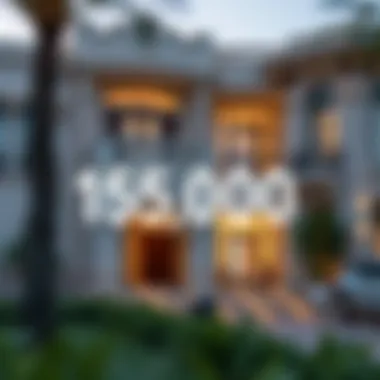Converting USD to AED: Insights on 150,000 Dollars


Intro
In today's interconnected world, understanding currency conversion isn't just a practical skill but a fundamental requirement for investors, homebuyers, and those looking to traverse international borders. With the United States dollar (USD) holding substantial weight in global finance, the act of exchanging it for United Arab Emirates dirhams (AED) is a common yet crucial task, particularly for those eyeing the bustling real estate market in Dubai. This article focuses on converting 150,000 USD into AED, navigating not only the mechanics of conversion but also the implications this conversion has within the context of investment opportunities and market trends.
The UAE's economy, particularly in cities like Dubai, possesses unique qualities, influenced predominantly by international trade, tourism, and a dynamic real estate landscape. Understanding these characteristics can seriously impact potential investments, making it vital for any investor or prospective buyer. In this exploration, we’ll delve into essential market insights, current trends, and strategic investment tips, ultimately helping you grasp the full picture surrounding this financial transaction.
Intro to Currency Conversion
Understanding currency conversion is a vital topic, especially for those looking to engage with international markets or make significant investments. In the context of converting 150,000 United States Dollars (USD) into United Arab Emirates Dirhams (AED), the implications stretch beyond mere numbers. It’s about grasping the complexities of how currency values interact in our globalized economy.
The Importance of Exchange Rates
Exchange rates serve as a mirror, reflecting the economic health of a country. Fluctuations in these rates can signal changes in inflation, interest rates, and overall economic stability. So why does this matter to us? When converting a considerable sum like 150,000 USD into AED, it’s crucial to know that even slight variations in the exchange rate can lead to significant differences in outcomes. For instance, let’s say the current rate is 3.67 AED for 1 USD.
- 3.67 AED conversion: 150,000 USD would equal 550,500 AED.
- If the rate moves to 3.70 AED, it then means only 555,000 AED in the new conversion.
That’s a tangible difference that can affect not just transactional value but also investment potential in markets such as Dubai’s real estate sector. Monitoring exchange rates is advisable for investors, as it highlights potential timing and strategy in capitalizing upon favorable shifts.
Factors Influencing Currency Values
Various elements sway currency values, creating a dynamic landscape. Investors must understand these factors to navigate conversions effectively. Some key influences include:
- Interest Rates: Higher rates offer lenders better returns, attracting foreign capital and causing the currency to appreciate.
- Economic Indicators: Employment rates, GDP growth, and consumer spending can paint a picture of economic robustness or fragility. Strong indicators often lead to currency appreciation.
- Political Stability: Regions with stable governance typically see a stronger currency. Unrest or political shifts can lead investors to seek safety in more stable currencies, which in turn affects the exchange valuation.
As an example, the robust economy paired with political stability in the UAE often results in a strong AED, making conversions less favorable for investors wanting to buy assets or properties in Dubai. So, looking ahead, keeping an eye on these variables can ensure that transactions and investments are well-timed and optimally valued.
Understanding USD to AED Conversion
Currency conversion has become a critical activity for anyone dealing with international transactions or investments. In the context of converting United States Dollars (USD) to United Arab Emirates Dirhams (AED), understanding the conversion process is not just about flipping a number. It involves appreciating the economic nuances, market trends, and potential investment opportunities that come into play.
When an individual or business considers converting 150,000 USD into AED, they must grasp the importance of knowing current exchange rates and what drives these rates. This knowledge empowers investors, realtors, and homebuyers to make calculated decisions, whether they're aiming to purchase property in Dubai or invest in the local economy. Failing to account for fluctuations in exchange rates or transaction fees can turn a seemingly straightforward conversion into a costly affair.
Current Exchange Rate Overview
As with any currency pair, the value of the USD against the AED fluctuates based on myriad factors. At present, the exchange rate sits at approximately 3.67 AED for 1 USD. This rate may vary throughout the day based on market forces. The market for foreign exchange is truly a global market with transaction volumes in the trillions of dollars. While institutions tend to operate with lower spreads, retail currency exchange operations often impose additional fees, so keep your eyes peeled.
For anyone seriously considering a currency conversion of 150,000 USD to AED, it’s advisable to stay updated on current rates. Checking reputable financial news portals or currency converter websites can help. Popular platforms such as XE.com or OANDA.com provide real-time data that are often more reliable than the rates offered at local banks or exchange offices.
Additionally, understanding the broader economic context that underpins currency values is pivotal. Geopolitical tensions, local economic performance, and even oil prices can influence how the AED performs against the USD. Therefore, deeper insights into the UAE's economic environment will shed light on persisting or emerging trends in the exchange rate.
Step-by-Step Conversion Process
Converting 150,000 USD to AED is a straightforward process but requires key steps to ensure accuracy and cost-effectiveness. Here’s a simple rundown:
- Check the Current Rate: Always start by gathering current exchange rates from reliable sources.
- Calculate the Gross Amount: Use the current rate to determine how much AED you would receive. For instance, using the rate of 3.67 AED per 1 USD, you would compute:
- Account for Fees: Include potential transaction fees that banks or exchange houses may charge. This often varies, and can eat into your conversion.
- Choose Your Method of Exchange: Depending on your needs, you can exchange money at a bank, an international money transfer service, or a physical exchange office. Each has different advantages and diversions when it comes to fee structures and reliability.
- Final Confirmation: Double-check the total amount you'll obtain after transaction fees. Don’t rush - take your time with it! Making a sudden hurried decision could lead to regrets later on.
- 150,000 USD × 3.67 AED/USD = 550,500 AED
- Banks: Generally offer stable rates but may impose higher fees.
- Money Transfer Services: Companies like TransferWise may provide competitive rates but check the fine print before you dive in.
- Physical Exchange Offices: These can be convenient but often carry higher spreads compared to online services.
By navigating through these steps diligently, the process of converting USD to AED becomes a calmer, more sensible endeavor, serving investors and homebuyers well when considering opportunities in Dubai’s thriving markets. Staying informed and cautious can convert mere currency into meaningful assets–both financial and real estate.
Investment Opportunities in Dubai


Investing in Dubai's real estate market can be a profitable venture. With a diverse range of options, it offers high potential returns, especially for those who understand the nuances of local dynamics. The booming economy, coupled with ongoing infrastructural developments, makes it an attractive territory for investors. The trend of expatriates moving to Dubai also brings a continuous demand for housing, which contributes to a stable market. Investing in this vibrant city not only provides opportunities but also comes with certain considerations that cannot be overlooked.
Real Estate Market Trends
The real estate market in Dubai has gone through several transformations over the years. Recently, the demand for residential properties has surged, particularly in areas like Dubai Marina and the Downtown district. These locations attract both tourists and long-term residents due to their amenities and lifestyle offerings.
Some key observations in the market include:
- Price Fluctuations: Over the past few years, property prices have experienced volatility, influenced by global economic conditions. Keeping an eye on market trends can help investors find the right moment to buy.
- Rental Yields: Dubai's rental yields are among the highest globally. Investors can expect returns that are considerably above the global average, which is a major draw.
- Luxury Estates in Demand: There’s a growing trend towards high-end properties, especially among affluent expatriates. Developers are catering to this demand with innovative designs and luxurious amenities.
As the market evolves, staying informed about these trends is crucial for making sound investment decisions.
High-Value Properties in Dubai
Dubai is home to some of the most unique and luxurious properties in the world. This includes skyscrapers with breathtaking views and exclusive gated communities. Investing in high-value properties can often be a double-edged sword, offering great rewards while also requiring a discerning approach.
Some notable high-value property types include:
- Villas in Palm Jumeirah: These villas not only provide a luxurious lifestyle but also a chance to tap into Dubai's upscale market. Investing here often means that property values will remain buoyant.
- Apartments in Burj Khalifa: Owning a unit in the world’s tallest building isn’t just about living in luxury; it's also a statement of status. Such properties often see high appreciation due to their unique positioning.
- Design-Driven Developments: New projects focus on sustainability and innovative design, appealing to modern investors looking for eco-friendly solutions.
The growth of high-value properties in Dubai is underpinned by unique designs and a global status that attracts affluent individuals from all corners of the world.
Investors need to approach high-value properties carefully. While they can provide significant returns, the initial investment is considerably higher, and one must conduct thorough market research to ensure alignment with personal investment goals. Knowing the ins and outs of such rich terrain can enhance the prospects significantly.
Demographic Insights and Their Impact
Understanding the demographic landscape in Dubai is crucial when considering the conversion of USD to AED and the subsequent investment opportunities. The rich tapestry of cultures and nationalities that converge in this modern city directly influences various markets, particularly real estate. For investors and homebuyers, recognizing these demographic dynamics can provide valuable insight into demand trends and pricing strategies.
There’s something unique about Dubai—its population is a melting pot. Let’s face it; it’s not just about numbers; it’s about where these people hail from and what buying power they bring with them. Expatriates represent a significant portion of the population, and their affluence or spending behaviors can shape local markets. With this in mind, let’s examine how expatriate influences and local trends intertwine to impact buyers.
Expatriate Influence in the Market
The expatriate population in Dubai is a driving force in the real estate market. With workers and families from numerous countries calling this city home, they bring diverse needs and financial capabilities. According to estimates, expatriates make up around 80% of Dubai’s population. This number has profound implications for property developers and realtors.
- Diverse Preferences: Expatriates are looking for various property options ranging from luxury villas to affordable apartments. Each group seeks different amenities based on their cultural backgrounds, lifestyles, and budgets.
- Investment Capacities: Many expatriates possess considerable disposable income, further bolstered by their native currencies. The ability to convert USD to AED while leveraging favorable exchange rates can bolster their purchasing power, often resulting in higher bids on properties.
- Cultural Adaptation: There�’s a comfort factor that expatriates seek, which often leads them to areas with similar communities or cultures. This trend creates concentrated demands in certain neighborhoods, affecting prices and availability.
In summary, the expatriate influence is substantial and contributes to shaping Dubai’s real estate market by boosting demand for properties and creating competitive pricing dynamics.
Local Trends Affecting Buyers
While expatriates are significant players, local trends also hold sway in the real estate market. Understanding these trends enables potential buyers and investors to make informed decisions.
- Economic Fluctuations: Local economic indicators such as unemployment rates, inflation, and GDP growth can directly affect buyer confidence. When the economy thrives, local buyers in Dubai feel more secure investing in property, and higher demand can drive prices up.
- Regulatory Changes: The UAE government frequently revises regulations regarding ownership laws and visa requirements. Buyers must stay informed about these changes, as they can significantly affect market accessibility and legitimacy of investment options.
- Urban Development: Dubai’s ongoing development projects, like the expansion of public transport or new shopping complexes, stimulate interest in nearby properties. Buyers want their homes to have good access to modern infrastructure and services.
- Sustainability Trends: There’s a growing awareness around sustainability among both locals and expatriates. Properties that highlight eco-friendliness and modern amenities often attract a premium.
The Role of Economic Conditions
When considering the conversion of USD to AED, it's crucial to understand the overarching economic conditions that frame this financial landscape. Particularly in today’s global economy, broad economic trends and local financial indicators play a vital role in exchange rates, which affect not only currency value but also investment opportunities. We cannot overlook how fluctuations can influence an investor's bottom line or a homebuyer's dreams.
Economic conditions provide a lens through which we can gauge market movements and thereby make informed decisions regarding large sums, like 150,000 USD. Investors and homebuyers need to grasp how global trends and local elements intertwine to influence currency strength in the UAE, which is a hub for expats, tourism, and international trade.
Global Economic Factors
Delving into global economic factors is akin to examining the roots of a tree; they provide essential context that feeds the exchange rates. One of the primary elements in this regard is the interest rates set by major economies. As nations like the United States manipulate their rates, this ripples through other economies. A rise in U.S. interest rates can strengthen the USD, thereby diminishing its value against the AED, if the UAE maintains consistent rates.


Furthermore, geopolitical stability is another significant player. Events like trade negotiations, international conflicts, or economic downturns can incite short-term volatility in exchange rates. All it takes is a headline to shift investors' confidence, leading to upward or downward adjustments.
On the other end, let’s not forget the impact of inflation trends. Low inflation tends to favor a strong currency because consumer purchasing power remains stable. In contrast, high inflation can erode this power, making currencies less attractive to hold.
Key Global Economic Influencers:
- Interest Rates: Fluctuations in interest rates directly affect currency values.
- Geopolitical Events: Situations like wars or trade deals can lead to sudden pricing shifts.
- Inflation Rates: They influence purchasing power and, subsequently, currency strength.
Local Economic Indicators
Focusing on local economic indicators allows for a more nuanced understanding of currency dynamics. For the UAE, factors such as the country’s oil reserves, government policies, and the overall health of the economy come into play.
Given that the UAE's economy is heavily linked to oil prices, any significant change in oil demand leads to a ripple effect on the AED's value. When crude oil prices soar, the UAE profits greatly, boosting confidence in its currency. Conversely, oil price declines can provoke a sense of caution among investors, affecting the market.
Trade balances represent another critical local indicator. A favorable trade balance means the UAE exports more than it imports, typically signaling a strong economy, which might lead to a stronger AED.
Thus, monitoring key indicators within the UAE economy is indispensable. These local elements can indicate not just where the AED stands now, but also how it may behave in upcoming months, aiding in making projections for conversions like our focus on 150,000 USD.
Important Local Economic Indicators:
- Oil Prices: Influence the UAE's revenue and currency stability.
- Trade Balance: A surplus suggests economic strength.
- Tourism Trends: High levels of tourism contribute positively to the local economy.
In short, understanding both global and local economic factors is essential for anyone looking to optimize their currency conversions, especially in relation to substantial sums such as 150,000 USD.
Calculating Value in AED
Calculating the value in AED (United Arab Emirates Dirham) is a crucial facet of understanding currency conversion, especially when dealing with significant sums like 150,000 USD. For investors, realtors, and homebuyers, knowing how to accurately assess this value allows for informed decisions when entering the dynamic Dubai real estate market. The exchange rate might fluctuate, but the underlying principles of effective conversion remain constant.
A proper calculation not only involves the current exchange rate but also the economic context surrounding it. Investors need to grasp how market trends, local economic conditions, and geopolitical influences can impact the conversion value. This strategic understanding arms them with essential insights, which may lead to better investment choices or negotiating power when acquiring properties in Dubai.
Direct Conversion of , USD
The direct conversion of 150,000 USD to AED is a straightforward yet essential process. As of now, let’s say the exchange rate is approximately 3.67 AED for every 1 USD. To convert directly:
150,000 USD * 3.67 AED/USD = 550,500 AED.
It is important to note, though, that exchange rates are not static. They may vary minute by minute based on market fluctuations. Consequently, a savvy investor should always check the real-time exchange rates before proceeding with any conversions, especially when dealing with substantial amounts. Fluctuations in rates can significantly affect the total amount one ends up with.
Tip: Always utilize reliable financial news sources or platforms like XE.com for real-time rates.
After calculating the rough direct conversion, it’s time to weigh other factors, especially transaction fees that may come into play.
Considerations for Transaction Fees
In currency exchange, the oft-overlooked aspect is transaction fees. These can vary widely based on whether you're converting through a bank, an exchange broker, or an online platform. Here are some considerations:
- Bank Fees: Many banks charge a flat fee or a percentage of the amount being converted. This can range from a few dollars to a significant percentage, depending on the institution.
- Exchange Rate Margins: Sometimes, the stated exchange rate may not reflect the rate at which you can actually convert your money. Banks and exchanges often add a margin to the rate to cover their costs.
- Online Platforms: Services like Wise or Revolut can be cost-effective alternatives for conversion, often providing better rates than traditional banks without hidden fees. However, one should still check their fee structures to get an accurate picture.
- Market Timing: Delaying a currency conversion until the market swings favorably can also save money in fees, particularly for larger amounts.
All these factors contribute to the final amount received in AED. It's essential for potential investors to analyze these aspects thoroughly to determine the net gains from currency conversion and make well-informed decisions for their investments in Dubai.
Potential Risks in Currency Exchange
Understanding the nuances of currency exchange is crucial for anyone dealing with significant amounts of money, such as the conversion of 150,000 USD into AED. While the potential benefits might be alluring, one must tread carefully due to the inherent risks involved. This section delves into two major risks: market volatility and timing the market, both of which are paramount for investors, real estate buyers, and anyone interested in the financial landscapes of the UAE.
Market Volatility


Market volatility refers to the fluctuations in exchange rates that can occur due to various factors such as economic indicators, political instability, and unforeseen global events. This volatility can have a direct impact on the amount of AED you receive for your USD. For example, if you decide to exchange your dollars when the market is down, you might end up receiving significantly less dirhams than anticipated.
Here are some specific elements to consider regarding market volatility:
- Economic Indicators: Reports on inflation, unemployment rates, and interest rates can swing currency values. A rise in interest rates in the US, for instance, might strengthen USD against AED.
- Political Events: Elections, government policies, and international relations influence market sentiment, directly affecting currency stability. Crises often create panic, destabilizing exchange rates, which could be detrimental if you're looking to maximize your investment.
- Global Economic Trends: Economic trends are rarely isolated; they are interconnected globally. Understanding global trade dynamics can provide insights into future currency movements.
“Currency exchange is like a dance; one misstep could cost you a fortune.”
Timing the Market
Timing the market is fundamentally about predicting when to execute a currency exchange to get the best rates. Many individuals believe they can outsmart the market, but unfortunately, this rarely yields favorable results. It's important to recognize the intricacies of timing. Here are a few considerations:
- Analyze Historical Data: Reviewing past currency movements can offer insights. However, remember that past performance does not guarantee future success. Trends may repeat, but they can also diverge significantly.
- Set a Budget: Determine ahead of time what rate would be considered acceptable for making the conversion. If the market dips below this point, execute your trade. This disciplined approach helps avoid emotional decision-making.
- Use Alerts: Many financial services let you set alerts for favorable currency rates. This technology can be invaluable for staying informed without having to constantly monitor the market.
The Future of the USD/AED Exchange Rate
Understanding the trajectory of the USD to AED exchange rate is critical for stakeholders across various fields—investors, realtors,homebuyers, and economists alike. As we explore this aspect, we will dive into the factors that shape these currencies' futures, including economic health and geopolitical influences. By recognizing the nuances involved, one can navigate currency conversion more effectively and make informed financial decisions.
Predictions and Projections
In examining predictions for the USD/AED exchange rate, it’s essential to consider a variety of economic indicators. Analysts often look at inflation rates, interest rates, and GDP growth projections to provide a fuller picture.
For instance, if the U.S. Federal Reserve were to increase interest rates, that might create a stronger dollar relative to the dirham. Conversely, if the UAE’s economy shows significant growth—or if oil prices surge—this may bolster the AED, potentially affecting the exchange rate positively.
To gain a deeper appreciation, consider these elements that analysts often assess:
- Macroeconomic Trends: Understanding both U.S. and UAE economic forecasts can help paint a clearer picture of future currency valuations.
- Monetary Policy: Central bank decisions can drive currency strength. For instance, the Fed’s tightening could lift USD demand.
- Technical Analysis: Certain analysts employ charting techniques to forecast movements in currency pairs based on historical data.
These combined perspectives relate closely not just to expectations about future values, but also about timing when to convert funds, especially large sums such as 150,000 USD.
"Keep an eye on the broader economic landscape; it offers clues not just about exchange rates, but overall investment potential."
Influence of Geopolitical Events
Another aspect that could substantially affect the future USD/AED exchange rate is the influence of geopolitical events. These shifts can create ripples across financial markets, prompting sudden legislative changes, trade agreements, or conflicts that impact economic conditions directly.
To illustrate, consider how tensions in the Middle East or changes in U.S. foreign policy may lead to fluctuations in oil prices. Since the UAE's economy is closely tied to oil, any unrest could either positively or negatively affect the AED, subsequently impacting the exchange rate with the USD. Specific events to keep an eye on include:
- Trade Agreements: Changes to existing trade policies can lead to varying levels of import/export costs, affecting currency values.
- International Conflicts: Tensions can lead to market uncertainty, causing investors to seek safety in currencies such as the USD.
- Economic Sanctions: Restrictions against countries can lead to shifts in currency demand, affecting exchange rates.
In summary, both predictions and geopolitical events are significant in shaping the future landscape of the USD/AED exchange rate. Tracking these indicators can empower stakeholders to make prudent decisions regarding currency conversion and investment strategies in the UAE’s real estate arena.
Culmination: Navigating Currency Conversion Effectively
Successfully converting 150,000 USD to AED involves not just understanding the numerical values but the broader context that surrounds such financial decisions. In a city like Dubai, where the economic landscape is shaped by numerous factors, grasping the intricacies of currency conversion holds significant importance for anyone looking to invest or engage in real estate. The way the dirham is positioned against the dollar can dramatically alter one's investment strategy.
When considering this conversion, investors must keep several key elements in mind:
- Current Exchange Rates: The fluctuating nature of exchange rates can affect the purchasing power of the dirham. It's vital to check the rates regularly as they can change frequently due to market dynamics.
- Economic Indicators: Keeping an eye on local and global economic indicators is crucial. These can signal potential shifts in currency value, helping predictions and investment decisions.
- Transaction Fees: Engaging with banks or currency exchange firms often comes with hidden costs. Understanding the fees involved ensures that investors get the best bang for their buck when converting currencies.
- Investment Climate: In Dubai’s ever-evolving market, things like regulatory changes, property tax implications, and demand trends can all have a say in the effectiveness of a currency conversion strategy.
Investors who navigate these waters effectively can enhance their cash flow and capitalize on favorable market conditions. With proper foresight and analysis, the process of converting USD to AED is not just a simple transaction but a doorway to broader investment opportunities.
"In any currency conversion, knowledge is power; the more informed an investor is, the better their potential success."
Key Takeaways for Investors
As we wrap things up, a few takeaways stand out for investors diving into currency conversion:
- Do Your Homework: Research the latest exchange rates and anticipate future trends to make informed decisions.
- Watch for Fees: Understand all transaction costs, as they can nibble away at profits.
- Stay Informed on the Market: Economic conditions can shift, so having a finger on the pulse is non-negotiable.
- Consider Timing: If possible, find opportune moments to exchange funds; timing can play a significant role in maximizing value.
- Seek Local Expertise: Collaborating with real estate professionals or financial experts in Dubai can provide valuable insights and aid in making the best conversion options.











